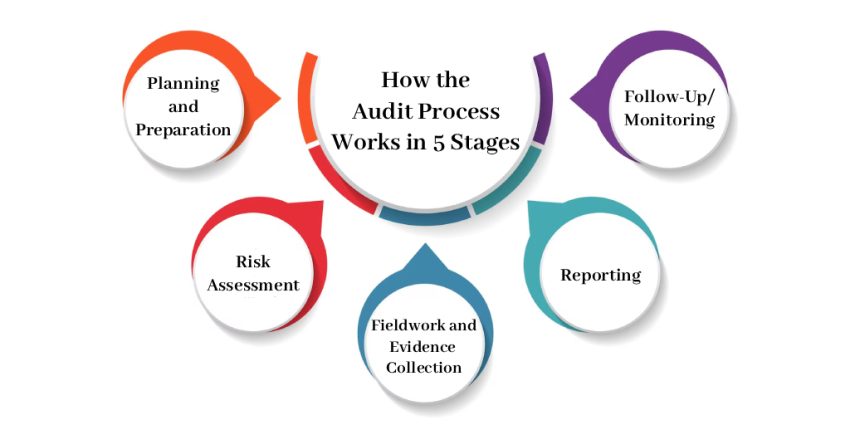Audits play a crucial role in ensuring accuracy, transparency, and compliance in business operations. Whether it is an internal audit or a statutory audit, following a structured process helps businesses maintain accountability and build trust with stakeholders. The 5 stages of audit process form the foundation of this structured approach, guiding auditors and businesses alike toward achieving clear and reliable results. Let’s explore these stages in detail.
1. Planning and Preparation
The initial phase depends on groundwork only during this stage, auditors become conversant with the company in terms of its business environment, industry and internal controls. They also determine the boundaries of the audit, determine time, and resource allocation. Planning makes the audit process smooth, ensuring that there is a proper focus on areas that involve greater risks or those that need more attention. Other processes also run out of track without correct preparation.
2. Risk Assessment
After planning, the next step of auditors is determining the possible risks. This will involve studying financial reports, internal control systems and systems to identify areas where losses or fraud may be committed. Risk assessment is also the most critical aspect of all stages of audit process since it aids the auditors in what aspects require more focus. It is also possible to evaluate these risks in advance and institute proactive measures to enhance the internal controls of the business.
3. Fieldwork and Evidence Collection
It is the third stage when the actual investigation work occurs. Auditors visit the area of operations, examine financial statements and perform procedures to obtain the evidence. This step guarantees the auditor that he or she has sufficient and valid information on his decision. Fieldwork can be the most labor-intensive among the stages of audit process since this phase involves critical testing of systems and transactions to determine their accuracy.
4. Reporting
Auditors then plan their report after collecting and evaluation of the evidence. This step will provide a summary of the findings, point discrepancies and give recommendations to improve. The audit report is important since it provides the management and the stakeholders with an accurate view of the financial and compliance status of the company. Reporting is one of the 5 stages in the audit process and during this stage; the results are reported in a fully structured and transparent way.
5. Follow-Up/ Monitoring
The last criterion concentrates on follow-up on management responses and control improvements taken. In some cases, auditors can take responsibility to revisit some areas to ensure improvements have taken place or whether risk to the part of an organization has been dealt with. The follow-up assists businesses to tighten up their systems and ensure that they never repeat their previous mistakes. It also creates confidence to stakeholders that it is not a mere exercise of requiring statutory compliance, but it is a continuous improvement tool.
Conclusion
It is helpful to have a clear understanding of stages of audit process of every company that processes transparency and accountability. The planning involved, risk measures, reporting, follow-up, among others are all significant parts in delivering credible results of an audit. When an audit is viewed as a method of continuous improvement rather than just a compliance issue, businesses will be able to not only improve their credibility but also mitigate the risks and secure growth in the long run.
This content is meant for information only and should not be considered as an advice or legal opinion, or otherwise. AKGVG & Associates does not intend to advertise its services through this.
Also Read: Process Audits: Streamlining Quality & Performance

